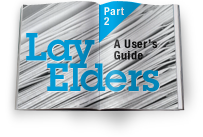The Contents and Purposes of the “Elder Packet”
If you are looking for an easy way to make your elders’ meetings more efficient, helpful, and unifying, then you might consider using what we call the “elder packet.”
PURPOSES OF THE PACKET
When Capitol Hill Baptist Church appointed our first slate of elders, friction unexpectedly arose between the staff and non-staff elders. At the heart of the problem was access to information. Staff elders spent a good part of their week together and naturally shared and vetted issues, while the non-staff elders were busy with their jobs. In early elders’ meetings, when the two groups came together, the non-staff elders found themselves pushed to make decisions in the meetings when they didn’t even know beforehand what was on the agenda, let alone have time to pray and think through the matters at hand.
We rectified this by requiring every elder who wanted to bring some matter to the board to write a memo and submit it to the elder chairman (and the shorter, the better!). The chairman then assembled all of these and passed them out one week prior to each elders’ meeting. This extra administrative step proved to be a huge aid to the non-staff elders, and it helped to unite the elders. It also forced long-winded brothers to write down their thoughts succinctly.
CONTENTS OF THE PACKET
Today, there are two main types of elders’ meetings at CHBC: member-centric meetings and issues meetings. The former focuses on all things related to membership, while the latter centers on important topics that the elders want to devote an evening to discussing. Below is a list of the typical documents included in the elders’ packets.
Member-Centric Meeting
For a “member-centric meeting,” there are two components to the packet: the main packet, and the membership packet. Here’s what gets put into both.
Main Packet:
- Agenda sheet
- Schedule of upcoming meetings
- Headlines and prayer: A time in which the elders briefly update the rest of the board about what is going on in their lives. Then the elders pray for each other.
- Hymn
- Scripture reading and prayer: The elders read aloud the passage of Scripture that will be preached the upcoming Sunday and then praise God in prayer for specific truths they see in the text.
- Minutes from the previous elders’ meeting
- Relationships reports: This report is generated from our church membership database. It is used to help the elders pray specifically for members of the church. We typically cover one or two letters of the alphabet (of members last names) in every meeting.
- Care list: In an effort to provide the best care for the congregation, the elders identify members who need particular care. The various categories of care include those living in unrepentant sin and those in some type of circumstantial, financial, or physical trial. The elders use this list to discuss how to best care for these members and then to pray for each of them.
- Memos: These include various items of business for the meeting. The presenter of each memo is also listed.
- Deacon review: Each elder is assigned to oversee and provide attention and care for a number of deacons.
- Executive session materials: The elders keep more pastorally sensitive discussions for the executive session portion of the elders’ meeting. At this time any invited guests— including pastoral assistants and CHBC interns—are asked to leave the meeting. All the materials needed for these discussions are included in the elders’ packet.
Membership Packet:
- Cover page: This page functions like a table of contents.
- Membership report: This document includes the most up-to-date additions and resignations as well as the names of any those whose membership is pending baptism.
- Photos of every applicant for membership
- New member applications
- Member resignations: Every member who seeks to join another church is asked to submit a resignation letter. These letters are included along with the person’s name, photo, and the church they are currently attending.
The membership packet varies in length depending primarily on the number of membership applicants.
Issues Meeting
Here is what goes into the main packet for an “issues meeting.”
Main Packet:
- Agenda sheet (as above)
- Upcoming meeting schedule (as above)
- Headlines and Prayer (as above)
- Hymn (as above)
- Scripture Reading and Prayer (as above)
- Elders’ Meeting Minutes (as above)
- Memos – This, too, is the same as above, but it typically takes up the lion’s share of the discussion time, as opposed to the “Relationship Report” and “Care List” described above. These memos include various items of business for the meeting. The presenter of each memo is also listed.
- Book Review – Sometimes the elders read through a book together and then review it chapter by chapter at the issues meeting. A different elder leads the discussion each time.
- Deacon Review (as above)
- Executive Session Materials (as above)
FYI Packet for Both Meetings
For both types of meeting, a “For Your Information Packet” is also included.
FYI Packet:
- Cover page: This page functions as a table of contents.
- No-Significant-Relationships Report: This report lists church members who, as far as the elders know, are not in any significant relationships with fellow church members. It is generated from our church membership database.
- Missionary updates: We include newsletters and updates from foreign workers sent out by CHBC.
- Financials Report
PULLING THE PACKET TOGETHER
One of the elder chairman’s main goals is to have a printed and digital copy of the elders’ packets to the elder board one week prior to the meeting. This ensures they have time to review the materials and can come prepared to the meeting.
Therefore, one week before elders meeting:
- A pastoral assistant puts together a draft of the agenda for the elders meeting.
- The chairman of elders reviews the agenda order and then finalizes the agenda.
- Once the agenda is finalized, a pastoral assistant ensures that all elder memos and other documents needed to create the elder packets have been received.
- A pastoral assistant prints out the materials and gets them in order.
- An intern or a pastoral assistant stuffs the materials in labeled envelopes and leaves them in the elders’ mailboxes at the church office.
- A pastoral assistant scans all packets and emails these digital versions to the elders for any who wish to read it on an eReader.
CONCLUSION
The elder packet process helps enable a free flow of information to the entirety of the elder board. It gives all the elders, staff and non-staff, an opportunity to come to the elders’ meetings prepared to better shepherd our congregation for Christ’s glory.









